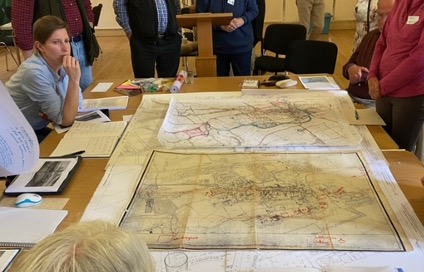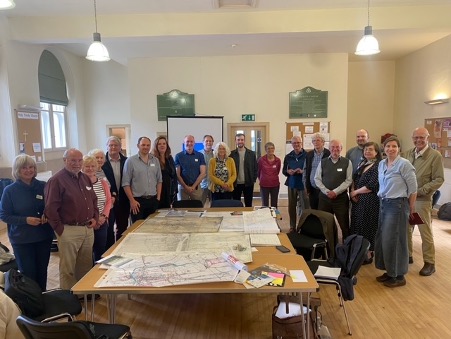Traces of the Past – Local Historians search the archives for the ‘Lost Fortifications’ of Haddington
Haddington’s History Society teamed up with the Scottish Battlefields Trust to organize the first ‘Siege Symposium’ on Friday the 1st of July the Trinity Centre.
A day long gathering of academics, archaeologists and local historians set out to determine the location of the long lost 16thC ‘Trace Italienne’ fortifications of the town.
The symposium was briefed on the history of the siege and the research that had been undertaken to date by Dr Jon Cooper from the Centre for War Studies and Conflict Archaeology at the University of Glasgow who opened his presentation thanking the Siege of Haddington Research Group (SHRG) for all the work they had done to date much of which was made available to researchers on the day.
Jon Cooper said ‘It was Mary of Guise who announced that the English left ‘nothing but the plague’ when they left the town in September 1549 – however we are convinced that traces of the fortifications can still be seen in the landscape today. This symposium is a chance for all the evidence found to date to be assessed and to discuss the next step in the search.’
The ‘Trace Italienne’ fortifications were the most up to date design of their era and were copied from those being built in southern Europe to resist the new gunpowder weapon technology. The English thought that the fort at Haddington would be the ‘Daunter of the Scots’. The fortifications did withstand everything the Scots and their French allies could throw at them but cost the lives of thousands and devastated the countryside all about East Lothian. Everything was levelled when the English left, but we believe we can still find the traces of the fort in the archaeological record.
The teams toured the town to look for evidence of the siege in the modern landscape stopping off at points where evidence of the 16th century townscape could still be spotted in the modern urban development.
After lunch the teams returned to search for primary evidence and discuss new concepts and theories as to the layout of the town in the 16th Century, the location of the English fortifications and the extent of the French siegeworks in the locality. The day concluded with each team presenting their findings and a group discussion expanding on the new-found evidence and theories.
The conference concluded that the research done to date was to be applauded but that there were plenty of further opportunities to be had around the town for further investigation.
Proposals were put forward for the digitization of primary sources currently held in the local archives and the creation of information databases that would help future local historians with their research.
The team looking at the construction and location of the fortifications were encouraged by the remains of the old town wall along the banks of the Tyne and around the Episcopal church concluding that a thorough survey of all the old walls of Haddington may shed light on the location of the 16thC defenses.
The Symposium ended with perhaps the most exciting piece of new evidence presented the team looking for the siegeworks built by the French who identified the possible location of a gun platform to the west of the town overlooking the Westport and the road to Edinburgh. New evidence suggested that this gun position was located to the west of Letham Drive and may still be present in the modern landscape. Further research and a desk-based analysis will be needed to assess the potential for this new site. If this does transpire to be the location of a ‘siege camp’ it will be the fourth to be identified in the local area.
The Siege of Haddington Research Group (SHRG) under the auspices of the Haddington’s History Society will continue to research the great siege over the coming summer months. If you wish to help with the enquiries or simply would like to know more about the siege then please contact Haddington’s History Society via their web page or visit the John Grey Centre’s Local History unit.
Jon Cooper from Glasgow University’s Centre for War Studies and Conflict Archaeology set the scene with the opening presentation.
Bess Rhodes (below) from St Andrews University led the team looking into the 16th Century Townscape.

Tom Addyman (l) (Addyman Archaeology), Dr David Caldwell (c) and Arran Johnston (r) (Scottish Battlefields Trust) consider the design of the fortifications.

Chris Upton (SHRG) led the team looking into the location of the siegeworks with Jenn Scott (Scottish Battlefields Trust), Kurt Readman (GUARD Archaeology / SHRG) and Kevin Munro (HES). It was this team that identified the possible site of the gun battery at Letham. Conservation Architect James Simpson OBE reviewed the work underway.

You must be logged in to post a comment.